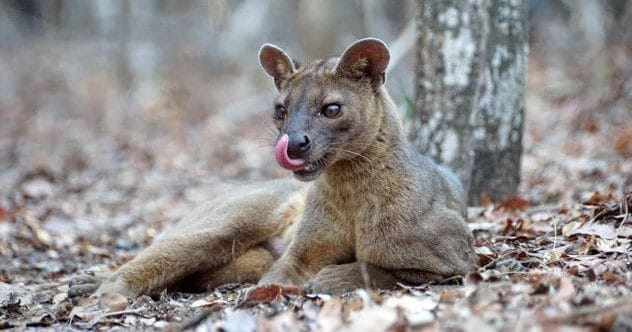The animal kingdom is full of fascinating creatures, each uniquely adapted to thrive in their specific environments. From camouflaged appearances to specialized senses, animals have evolved in incredible ways. Let’s explore some of the most interesting and unusual examples of these unique environmental adaptations.
10. Narwhal
The narwhal, found in the Arctic waters of Canada, Greenland, and Russia, features a long, spiral tusk, which is actually a modified front tooth that can grow up to 10 feet long. This tusk serves multiple purposes, like hunting, attracting mates, and social displays. It also contains nerve endings that detect changes in temperature, pressure, and salinity, helping narwhals to navigate and find food in low-light conditions.
Additionally, narwhals possess a specialized circulatory system that conserves heat in the extreme Arctic conditions. Their flexible ribcage also allows them to compress their lungs, conserving oxygen when diving to great depths. These adaptations enable narwhals to thrive in their harsh environment.
9. Hoatzin
The hoatzin, a bird from the swamps and wetlands of South America, has a digestive system specialized for a herbivorous diet. Unlike other birds, the hoatzin has a large, multi-chambered foregut, allowing it to ferment tough plant matter. This process produces methane gas, earning it the nickname “stinkbird.”
The hoatzin’s digestive system is highly efficient, extracting more nutrients from its food than other birds. Young hoatzins also have wing claws, remnants of their evolutionary past, that help them climb back into the nest if they fall out. These unique features allow the hoatzin to thrive in its wetland habitat.
8. Axolotl
The axolotl, native to the freshwater lakes and canals of Mexico City, is known for its incredible ability to regenerate limbs, spinal cords, hearts, and other organs throughout its life. This makes them valuable for research into tissue regeneration and repair.
Axolotls also exhibit neoteny, remaining in their larval form throughout their lives, retaining juvenile features like external gills and a long tail. They can breathe through their skin, absorbing oxygen directly from the water, which helps them survive in low-oxygen environments. These adaptations make the axolotl a fascinating species.
7. Sun Bear
The sun bear, found in the tropical forests of Southeast Asia, is known for its long, curved claws adapted for climbing trees. Sun bears have muscular builds and powerful forelimbs, making it easy to climb and forage for food high in the canopy. They also have a remarkably long tongue, up to 10 inches, used to extract honey and insects from tree bark.
The sun bear’s tongue is covered in small, backward-facing papillae, aiding in gripping insects. This adaptation allows them to feed on ants and termites, which are a major part of their diet. The sun bear’s specialized tongue showcases their remarkable ability to adapt to their environment.
6. Aye-Aye
The aye-aye, a primate unique to Madagascar, has a long, thin, and flexible middle finger used to extract insects from tree bark. The aye-aye taps on the bark, listening for hollow chambers indicating insects, then uses its teeth to gnaw through the bark and its finger to extract the prey. This is the only primate known to use echolocation to find prey.
The aye-aye’s large, sensitive ears help locate insects moving beneath the bark. Their independently rotating ears pinpoint prey with remarkable accuracy. Their large eyes help them see in low-light conditions. These adaptations make the aye-aye a specialized predator in its forest habitat.
5. Flying Squirrel
The flying squirrel, found in forests across Europe, Asia, and North America, glides through the air using flaps of skin called patagia, stretching from its front to hind legs. When leaping from a tree, the squirrel spreads its patagia, creating a parachute-like surface for gliding up to 295 feet. This helps them avoid predators and navigate the forest efficiently.
Flying squirrels have a keen sense of hearing, locating nuts, seeds, and insects. Their sensitive ears detect high-frequency sounds. Sharp claws and strong hind legs enable them to climb trees easily. These adaptations have allowed flying squirrels to thrive in forest habitats for millions of years.
4. Pangolin
The pangolin, or scaly anteater, found in Asia and Africa, is covered in overlapping scales made of keratin. These scales protect against predators and insect bites. Pangolins have a long, sticky tongue to capture up to 70 million insects per year.
When threatened, pangolins curl into a tight ball. They have strong forelimbs and sharp claws for digging burrows and excavating insect nests. Despite these adaptations, pangolins are heavily trafficked, making conservation crucial for their survival.
3. Goblin Shark
The goblin shark, a deep-sea predator, has survived due to its unique adaptations. Its elongated snout has an electro-sensory system that detects electrical fields produced by prey buried in the seabed.
Goblin sharks have protruding jaws that extend up to 8% of their body length, allowing them to catch prey out of reach for other predators. Needle-like teeth easily penetrate the shells of crustaceans and mollusks. These adaptations make the goblin shark an effective deep-sea predator.
2. Water Opossum
The water opossum, or yapok, found in Central and South American freshwater habitats, has partially webbed hind feet for swimming, the only marsupial with this adaptation. They spend most of their lives in the water and can hold their breath for up to 20 seconds while diving for food.
Water opossums can close their nostrils and ears underwater, preventing water intake. Their water-resistant fur and tail acting as a rudder help them maneuver through the water. These adaptations allow them to thrive in aquatic environments.
1. Fossa
The fossa, a carnivorous mammal exclusive to Madagascar, is the island’s largest predator. Its elongated and flexible spine allows it to navigate the dense rainforest vegetation. Powerful hind legs and sharp claws enable it to climb trees and capture prey on the ground and in the trees.
The fossa’s strong jaw and sharp teeth are essential for hunting lemurs. Its jaw can open to a 180-degree angle, allowing it to take down large prey. A keen sense of smell helps it track prey in the rainforest. These adaptations make the fossa a vital part of its ecosystem.
From the depths of the ocean to the canopies of rainforests, animals have evolved incredible adaptations to thrive in their environments. Each species showcases the remarkable power and diversity of nature’s ingenuity.
Which of these amazing animal adaptations impressed you the most? Leave your comment below!










